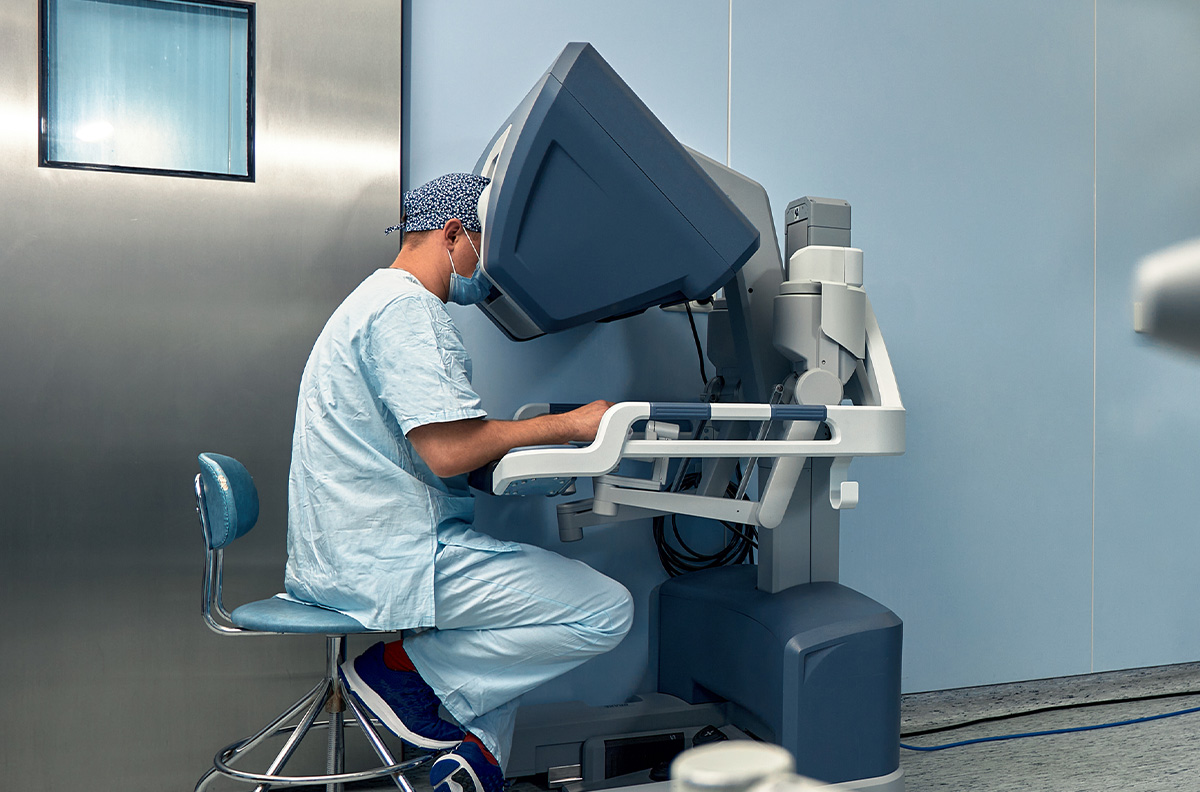Endoscopic Sleeve Gastroplasty
Endoscopic sleeve gastroplasty helps you lose weight quickly. With this method, you can lose weight and get rid of conditions such as diabetes.
Contents
Overview of Endoscopic Sleeve Gastroplasty
For those with obesity-level weight problems, surgical methods such as sleeve gastrectomy and gastric bypass are applied. In addition to these surgical methods, non-surgical methods can also be considered. One of the non-surgical methods applied is endoscopic sleeve gastroplasty. This method is also known as non-surgical sleeve gastrectomy. Many people wonder, “What is non-surgical sleeve gastrectomy?”
Endoscopic sleeve gastroplasty is performed on obese patients who meet the necessary conditions. In this method, the stomach is stitched through the mouth. These stitches reduce the volume of the stomach. The absence of incisions makes this procedure safer compared to surgical operations. Bariatric surgery methods can sometimes frighten patients. Additionally, the patient’s psychological condition and past illnesses can be obstacles to surgical methods. For individuals with very high body mass indices, surgical procedures are more appropriate. However, non-surgical sleeve gastrectomy is preferred for those who do not have advanced obesity problems.
Patients who cannot achieve weight loss through surgical procedures may need a new intervention. In such cases, endoscopic surgery can be performed as a revision. As with all interventions, how the patient manages the post-procedure process is crucial for weight loss. If the patient does not adhere to the nutrition plan and exercise, it is not possible to lose weight. In such cases, side effects such as pain and discomfort are more frequent. Therefore, it is essential that the patient undergoes a comprehensive evaluation and receives information from various doctors before the procedure.
How is Endoscopic Sleeve Gastroplasty Performed?
The question “How is non-surgical sleeve gastrectomy performed?” is often asked by many. Patients are particularly curious about the changes that will occur in their stomachs. During the procedure, specialized instruments are used to reach the stomach. The stitches placed in the stomach reduce its volume. No part of the stomach is removed. A new, smaller stomach is created solely with stitches.
The patient must be fasting before the procedure. The intervention is performed under general anesthesia, ensuring that no pain or discomfort is felt during the procedures. Endoscopy is used during the operation. Stitches are placed using a device called an overstitch. These stitches are placed on the left side of the stomach, which is folded and stitched.
During endoscopic sleeve gastroplasty, no intervention is made to the intestines. There is no removal of parts from the digestive system or stitching the intestines to a different location. Therefore, the natural digestive mechanism remains unchanged. The operation, which lasts about an hour, results in rapid weight loss.
It is generally possible to leave the hospital on the same day after the procedure. In necessary cases, a one-day hospitalization may be required.
Endoscopic sleeve gastroplasty is considered safe by the FDA. The physiological differences following the intervention allow the patient to lead a healthier life.
Who is Suitable for Endoscopic Sleeve Gastroplasty?
Endoscopic sleeve gastroplasty is a suitable method for those who cannot lose weight after long periods of dieting and exercising. Losing weight is often not an easy task. A patient may lose weight for a certain period but regain it later. This cycle continues for a long time, eventually leading to obesity. In such cases, individuals troubled by the problems caused by excess weight can opt for non-surgical sleeve gastrectomy.
This procedure is not suitable for individuals with hiatal hernia and gastritis problems. It is also preferable to use different methods if the patient has a peptic ulcer. If the body mass index is over 40, surgical intervention is more appropriate. However, the doctor’s evaluation is crucial in such cases.
Normally, the body mass index should be 35 or above. If the patient has other conditions that can improve with weight loss, the body mass index can be 30. Psychiatric approval is required for stomach reduction procedures. Additionally, evaluations should be made by endocrinologists, internal medicine specialists, and dietitians.
Individuals who want to lose weight with this method must be prepared for the post-operative period. If the patient has existing psychological problems, pre-intervention therapy is applied when necessary. It is also essential to treat alcohol and smoking addiction. Non-surgical sleeve gastrectomy is also performed on patients after obesity surgery. This method can be preferred for revision.
How Should Nutrition Be After a Non-Surgical Sleeve Procedure?
When non-surgical sleeve gastrectomy is chosen for weight loss, a specific dietary regimen must be followed. The nutrition process is similar to that after surgical procedures. Initially, the patient consumes liquid foods for a few weeks. However, it is essential to proceed under the supervision of a dietitian.
Following endoscopic sleeve gastroplasty, after a month of liquid nutrition, the patient transitions to pureed foods. Subsequently, solid foods are introduced gradually. Dietitian recommendations should be considered during the nutrition phases.
After endoscopic sleeve gastroplasty, a lifestyle change is necessary. In other words, a healthy eating regimen must be maintained throughout life. It is important to chew food thoroughly before swallowing. Additionally, water consumption should not be simultaneous with meals. Water should be consumed an hour before and after meals. Drinking water slowly and in sips is another important detail.
Avoiding acidic foods and fried items is essential. Excessively fatty foods and carbohydrates should be consumed in moderation, as they can cause weight gain. Exercising is crucial for achieving more efficient results in the long term. Even light-paced walking plays a significant role in increasing and maintaining weight loss. Various sports can be performed according to the doctor’s advice in the long run. Exercising is important to prevent muscle loss during the weight loss process. It also helps to prevent sagging.
Avoiding acidic foods and fried items is essential. Excessively fatty foods and carbohydrates should be consumed in moderation, as they can cause weight gain. Exercising is crucial for achieving more efficient results in the long term. Even light-paced walking plays a significant role in increasing and maintaining weight loss. Various sports can be performed according to the doctor’s advice in the long run. Exercising is important to prevent muscle loss during the weight loss process. It also helps to prevent sagging.
While following the nutrition program, it is important for the patient to gauge their fullness correctly. You should stop eating as soon as you feel full. It is also important not to overwhelm your stomach by spreading out meals and snacks throughout the day. The foods in the nutrition program should be rich in vitamins and minerals. This way, vitamin deficiencies and related problems caused by weight loss can be avoided.
What Are the Risks of Endoscopic Sleeve Gastroplasty?
Reviews from those who have undergone non-surgical sleeve gastrectomy are generally positive. The most common symptoms are nausea and vomiting. The patient may need to use medication for a certain period to alleviate these symptoms. Usually, two days after the procedure, the patient can comfortably continue their life. Although endoscopic sleeve gastroplasty can be reversed in necessary cases, this is rarely needed.
Compared to obesity surgery, the risks of non-surgical sleeve gastrectomy are significantly lower. Side effects rarely occur. The risk of bleeding is very low, and antibiotics can be administered to further reduce this risk. The likelihood of infection and leakage is also low. Blood thinners are given to the patient to mitigate the risk of clotting.
If effective results are not achieved with endoscopic sleeve gastroplasty, obesity surgery methods can also be applied. However, to avoid further interventions on the stomach, the patient must adopt a new lifestyle. Patients who learn what to do before the operation should be determined and willing to lose weight.
Endoscopic sleeve gastroplasty should be performed under hygienic conditions and by a specialist doctor. An expert doctor can significantly reduce the risks associated with stomach operations.
What Are the Differences Between Non-Surgical Sleeve and Sleeve Gastrectomy?
There are several important differences between non-surgical sleeve gastrectomy and surgical sleeve gastrectomy. Firstly, in the non-surgical sleeve method, no incisions are made on the body, so there are no scars after the procedure. In contrast, surgical sleeve gastrectomy involves making incisions in the abdominal area and removing about 80% of the stomach, resulting in a banana-shaped stomach.
There are several important differences between non-surgical sleeve gastrectomy and surgical sleeve gastrectomy. Firstly, in the non-surgical sleeve method, no incisions are made on the body, so there are no scars after the procedure. In contrast, surgical sleeve gastrectomy involves making incisions in the abdominal area and removing about 80% of the stomach, resulting in a banana-shaped stomach.
If weight loss is insufficient, sleeve gastrectomy cannot be reversed. In the non-surgical method, there is a possibility of reversal. In the non-surgical sleeve method, no incisions are made on the abdomen, so there are no visible signs of the operation on the patient’s body. For sleeve gastrectomy, the body mass index must be higher. Unless necessary, individuals with a body mass index below 40 are not operated on. In the non-surgical method, the body mass index can be between 30-40.
Patients who are inclined towards non-surgical methods can also opt for a gastric balloon. In the gastric balloon procedure, a medical device is placed in the body. This device is inflated to form a balloon. The balloon has no adverse effects and is expelled from the body after a certain period. Endoscopic sleeve gastroplasty, compared to the balloon, offers more permanent weight loss. The doctor decides which method is suitable for the patient.







